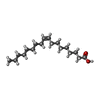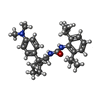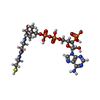+Search query
-Structure paper
| Title | Structure of nevanimibe-bound tetrameric human ACAT1. |
|---|---|
| Journal, issue, pages | Nature, Vol. 581, Issue 7808, Page 339-343, Year 2020 |
| Publish date | May 13, 2020 |
 Authors Authors | Tao Long / Yingyuan Sun / Abdirahman Hassan / Xiaofeng Qi / Xiaochun Li /  |
| PubMed Abstract | Cholesterol is an essential component of mammalian cell membranes, constituting up to 50% of plasma membrane lipids. By contrast, it accounts for only 5% of lipids in the endoplasmic reticulum (ER). ...Cholesterol is an essential component of mammalian cell membranes, constituting up to 50% of plasma membrane lipids. By contrast, it accounts for only 5% of lipids in the endoplasmic reticulum (ER). The ER enzyme sterol O-acyltransferase 1 (also named acyl-coenzyme A:cholesterol acyltransferase, ACAT1) transfers a long-chain fatty acid to cholesterol to form cholesteryl esters that coalesce into cytosolic lipid droplets. Under conditions of cholesterol overload, ACAT1 maintains the low cholesterol concentration of the ER and thereby has an essential role in cholesterol homeostasis. ACAT1 has also been implicated in Alzheimer's disease, atherosclerosis and cancers. Here we report a cryo-electron microscopy structure of human ACAT1 in complex with nevanimibe, an inhibitor that is in clinical trials for the treatment of congenital adrenal hyperplasia. The ACAT1 holoenzyme is a tetramer that consists of two homodimers. Each monomer contains nine transmembrane helices (TMs), six of which (TM4-TM9) form a cavity that accommodates nevanimibe and an endogenous acyl-coenzyme A. This cavity also contains a histidine that has previously been identified as essential for catalytic activity. Our structural data and biochemical analyses provide a physical model to explain the process of cholesterol esterification, as well as details of the interaction between nevanimibe and ACAT1, which may help to accelerate the development of ACAT1 inhibitors to treat related diseases. |
 External links External links |  Nature / Nature /  PubMed:32433613 / PubMed:32433613 /  PubMed Central PubMed Central |
| Methods | EM (single particle) |
| Resolution | 3.67 Å |
| Structure data | EMDB-21390, PDB-6vum: |
| Chemicals |  ChemComp-OLA:  ChemComp-CLR:  ChemComp-ROV:  ChemComp-COA:  ChemComp-3VV: |
| Source |
|
 Keywords Keywords | MEMBRANE PROTEIN / cholesterol / cholesteryl ester / acyltransferase / MBOAT |
 Movie
Movie Controller
Controller Structure viewers
Structure viewers About Yorodumi Papers
About Yorodumi Papers





 homo sapiens (human)
homo sapiens (human)